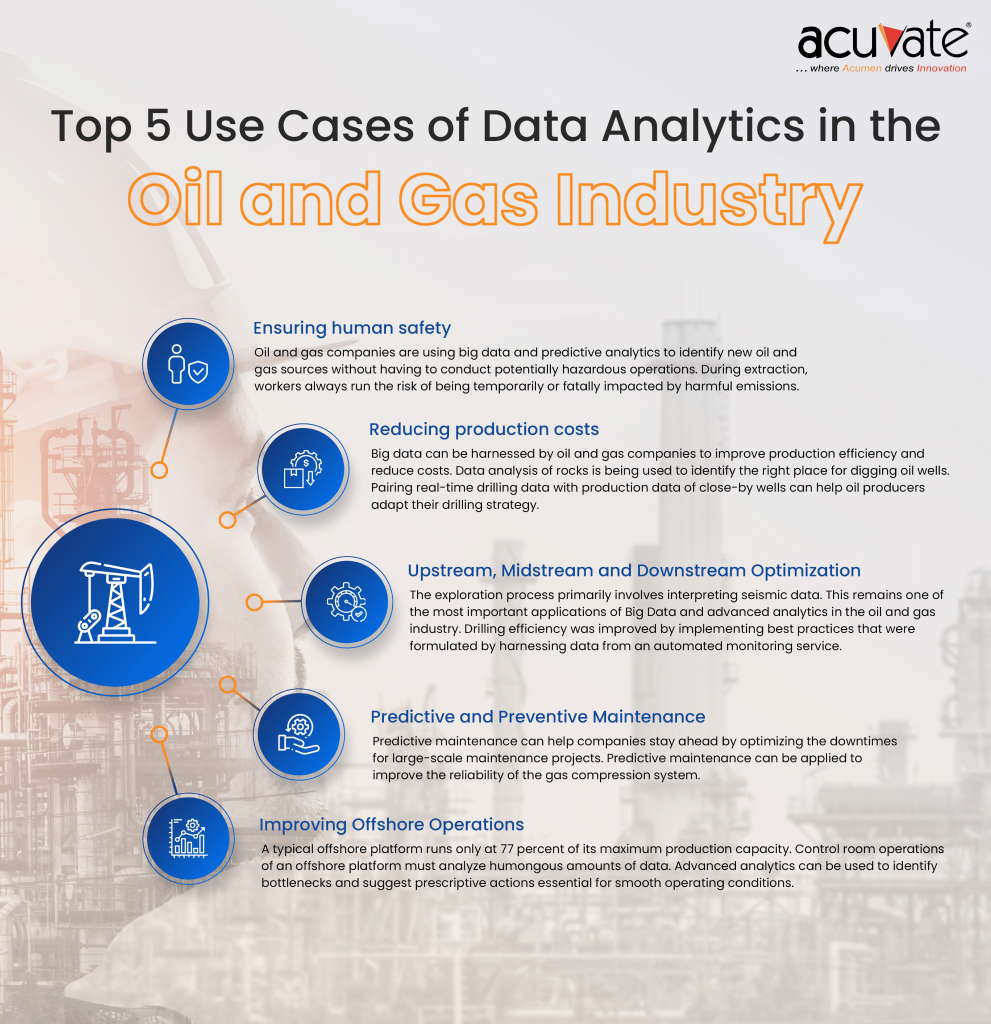Advanced Data analytics has made a considerable impact on the oil and gas (O&G) industry be it in enhancing ROI or enabling safety measures. According to a report by McKinsey, advanced analytics has yielded returns amounting 30-50 times the investment within a few months when implemented effectively.
O&G is an industry that heavily depends on data to run its processes, owing to which Advanced Data Analytics has proven useful in various facets of this industry. Exploration, drilling, production operations, analyzing seismic and micro seismic data, improving reservoir characterization and simulation, asset management and occupational safety are some of the key areas where advanced analytics are extensively used to glean insights.
The same report cited above reveals that most offshore platforms operate at approximately 77% of their maximum utilization. Across the industry, this shortfall in utilization equates to US$200 billion in annual revenue. The prominence of Advanced Data Analytics in the O&G industry has been fueled by the industry’s ever-growing reliance on data and the need to push the boundaries in exploration and production processes.
Use cases :
- Ensuring human safety
- Reducing production costs
- Upstream, Midstream and Downstream Optimization
- Predictive and preventive maintenance
- Improving Offshore operations predictions

5 Use Cases Of Advanced Data Analytics In The Oil And Gas Industry
1. Ensuring human safety
One of the major challenges facing the oil and gas industry is ensuring the safety of the workforce and the environment, especially during the drilling process. During extraction, the workers always run the risk of being temporarily or fatally impacted by harmful emissions. In order to reduce this risk, O&G companies today are using big data and predictive analytics to identify new oil and gas sources without having to conduct potentially hazardous operations.
2. Reducing production costs
There are numerous internal and external factors right from well drilling to pipeline operations that influence the production costs of an oil and gas organization. This data can be harnessed by big data analytics and used in various scenarios to improve production efficiency and bring down costs. For example, data analysis of rocks is being used to identify the right place for digging oil wells; Pairing real-time down-hole drilling data with production data of close-by wells can help oil producers adapt their drilling strategy. Companies like Shell are using Advanced data analytics to determine the amount of oil and gas left in reservoirs and forecast production.
According to Bain & Company, Advanced data analytics has the potential to increase oil and gas production by 6%-8%.
3. Upstream, Midstream and Downstream Optimization
Some of the challenges in the upstream processes of the oil and gas industry involve improving the performance of existing resources and finding new resources (exploration) to maintain a continuous supply of crude oil. The exploration process primarily involves interpreting seismic data which demands sophisticated computing equipment with powerful visualization capabilities. The seismic data is used to create a subsurface picture. This remains one of the most important applications of Big Data and Advanced Data analytics in the oil and gas industry.
Advanced Data analytics has grown in importance in drilling operations due to the extensive use of sensors that record various parameters throughout the drilling process. These parameters are then used to generate insights that help the extraction process. In an operation conducted by petroleum engineers, the drilling rig efficiency was improved by implementing the best practices that were formulated by harnessing data from an automated monitoring service. The data that was used to glean insights included the detected conditions of the drilling process. This produced savings of more than 11.75 days and the total non-drilling time was improved by 45%.
Data analytics has also been used to develop a reservoir management application and improve the modeling of reservoirs by analyzing the production data. Engineers have deployed advanced analytics to develop a smart forecast and flow method to identify the underlying pattern in production data and to forecast the production performance.
Advanced analytics is increasingly being used to improve shipping performance by predicting the propulsion power that enhances the performances of ships and lowers greenhouse gas emissions.
4. Predictive and Preventive Maintenance
Usage of predictive analytics has enabled O&G companies to create simulations that predict maintenance events. Predictive maintenance reduces the costs of unforeseen reactive maintenance and downtimes. In the long run, these predictions can help companies stay one step ahead by optimizing the downtimes for large-scale maintenance projects.
Another application is reducing unplanned downtime due to failures in critical equipment. Predictive maintenance can be applied to improve the reliability of the gas compression system – a critical component at many offshore platforms that leads to large losses during downtimes. Algorithms can be used to predict failures in a gas compressor train with more than 70% accuracy and increase production.
In addition to predictive maintenance, organizations can look into adopting the preventive maintenance approach which involves inspection and replacement of equipment at regular intervals of time.
5. Improving Offshore Operations
According to a report by McKinsey, a typical offshore platform runs only at 77 percent of its maximum production capacity. On an average, this shortfall represents $200 billion in annual revenue. A primary reason for this performance gap is the operational complexities in production and processing facilities. Control room operations of an offshore platform must analyze humongous amounts of data generated by as many as 30,000 sensors and also consider external factors that influence the production including temperature, humidity and wave heights.
Advanced analytics powered by machine learning leverage statistical methods to analyze highly complex and copious amounts of data and find patterns. These patterns can then be used to build algorithms which analyze the factors critical to production, efficiency and quality, alert operators about potential scenarios in the future that can impact rig operations, and enable them to respond in time. Advanced analytics can be used to identify bottlenecks and suggest prescriptive actions essential for smooth operating conditions.
If you’d like to learn more about this topic or planning to implement data analytics in your organization, please feel free to get in touch with our data analytics and oil and gas experts for a personalized consultation. You might also be interested in exploring our analytics and database services for more insights.



